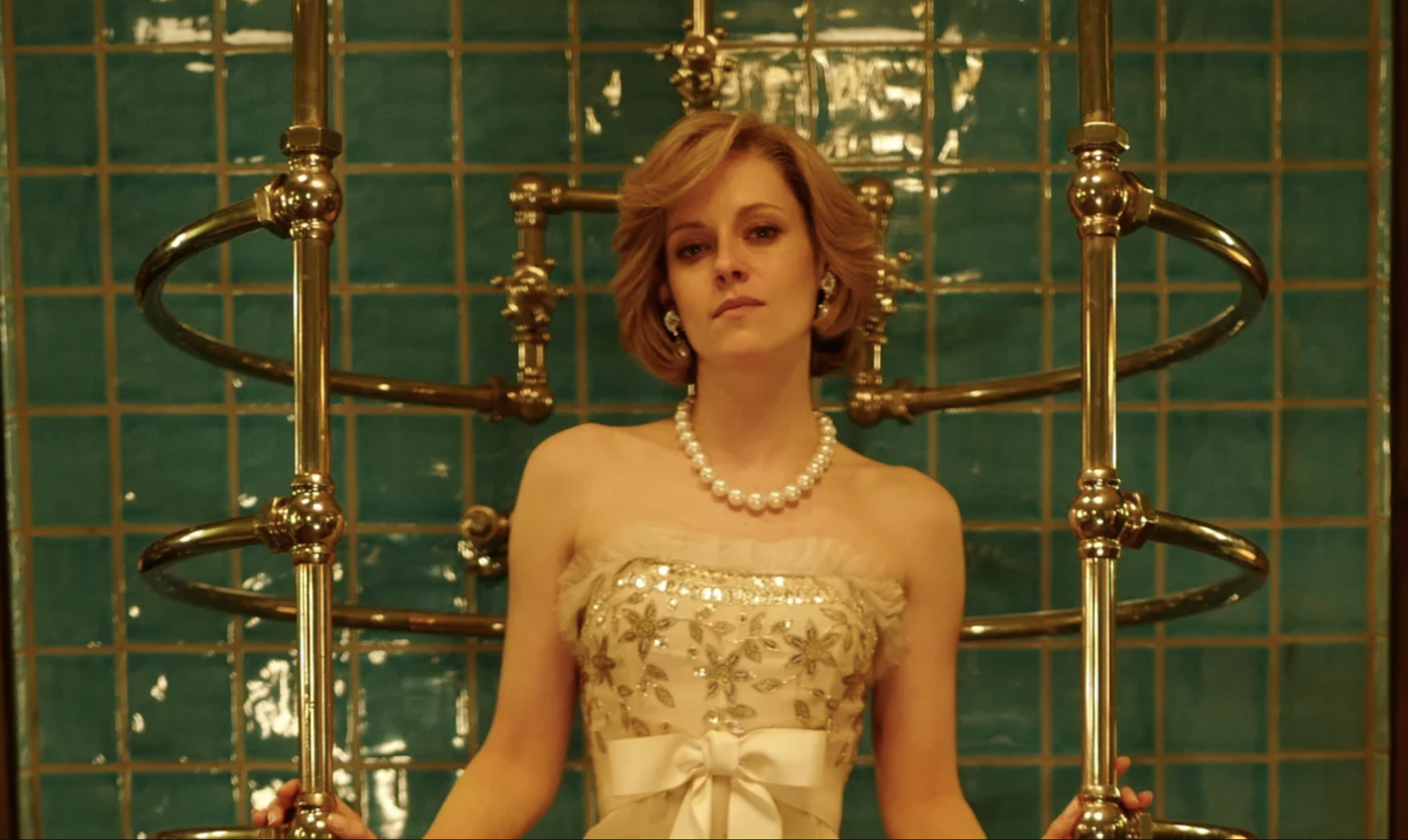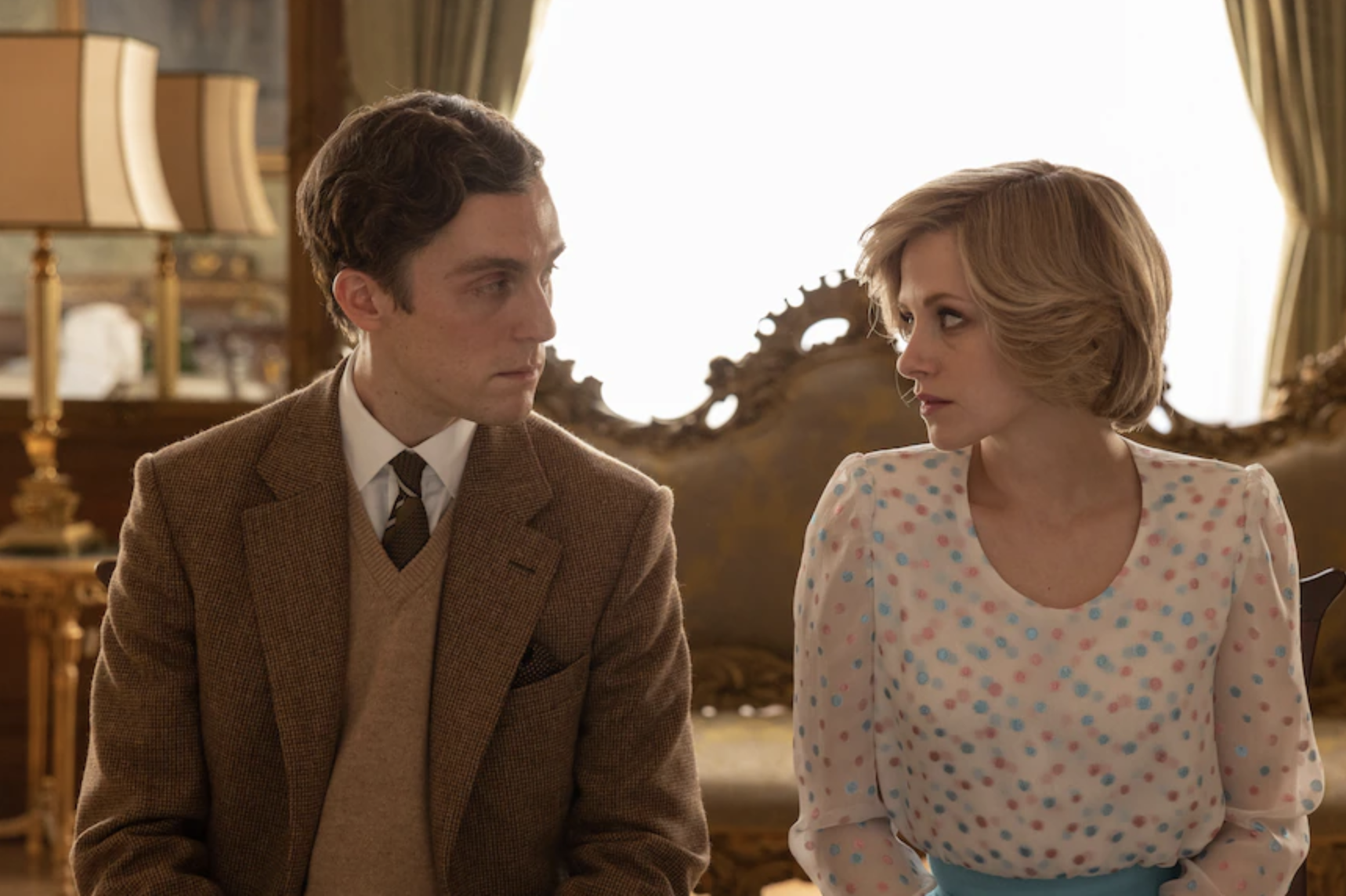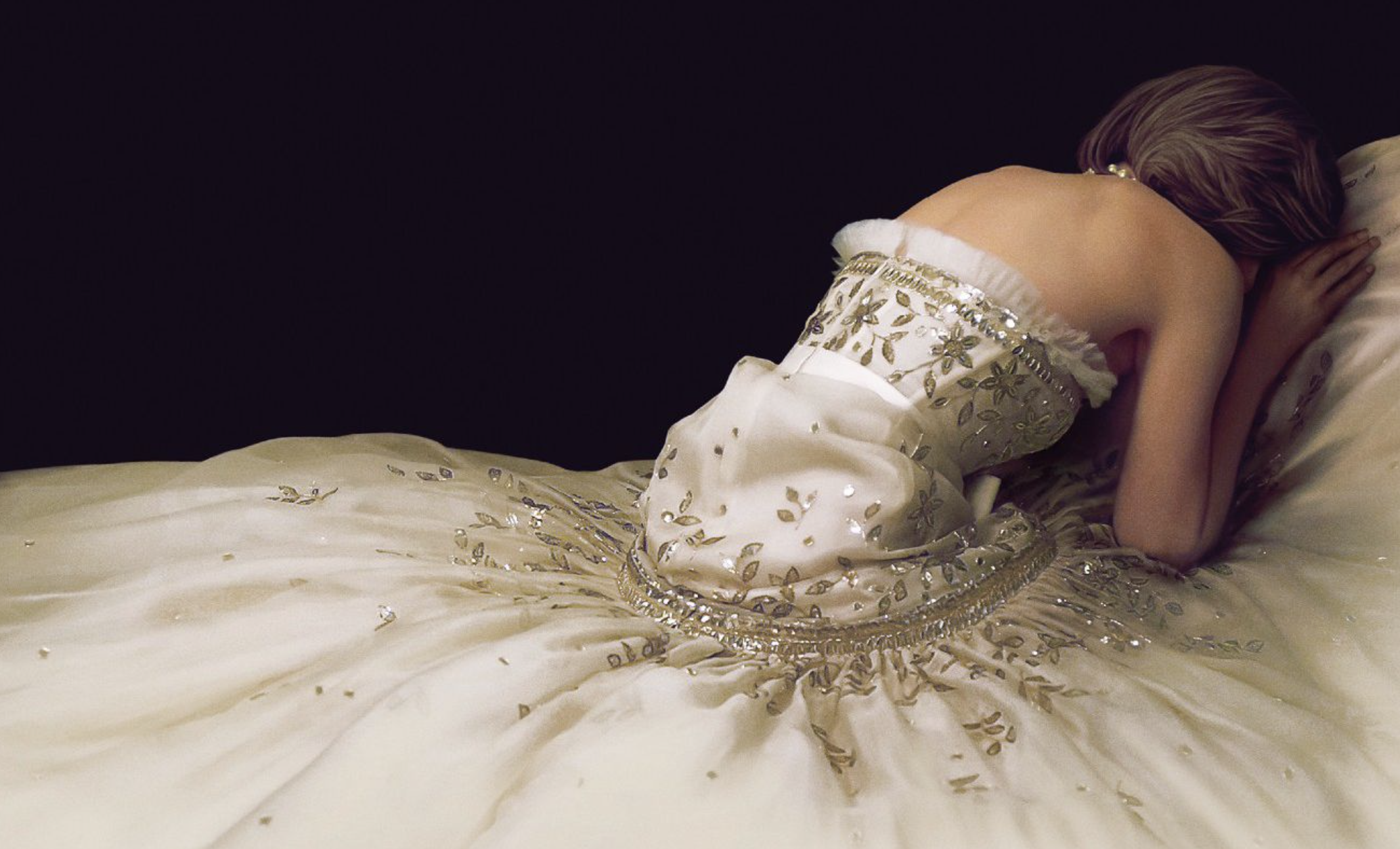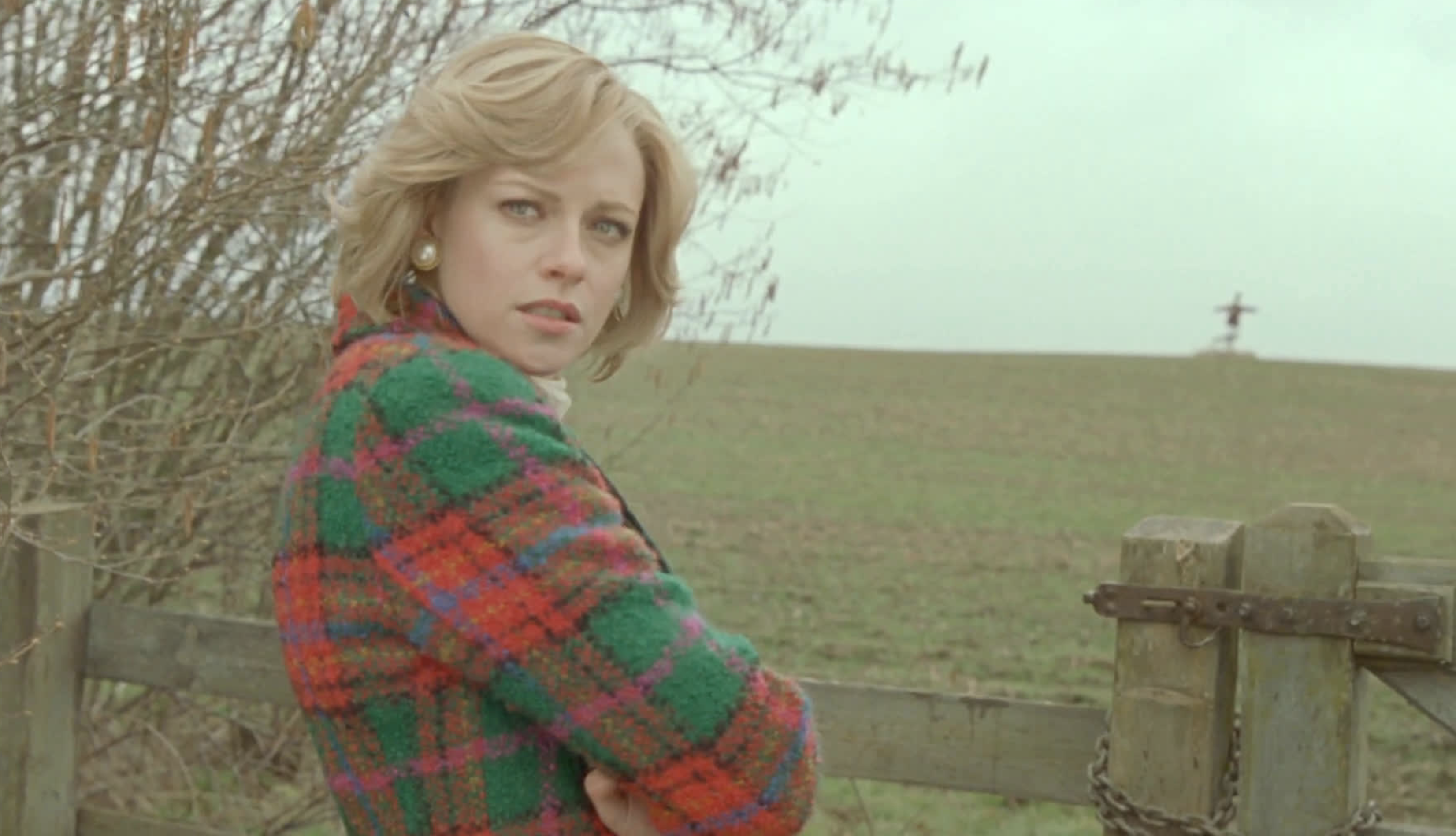
Princess Diana died five years before I was born, an ocean away, so I’m the last person with any right to feel a connection to her. And yet, for her elegance and strength, for her Achilles-esque infirmity of carefully concealed faults, and most of all for her mature radiance that wasn’t allowed time to fully unfold, I want to know her.
On February 8, 2022, Kristen Stewart received her first Oscar nomination. My thoughts went immediately to my watch of her film, Spencer (2021), released last November. Gilded yet unnerving, the film was a Christmas tree trimmed with a tense undercurrent of tragic instability. Stewart’s Diana is a trembling star atop the evergreen. From the iconic poster, which I stumbled upon on Instagram—that dress!—to the sense-jolting soundtrack swirling around the theater, Pablo Larraín had created a royal experience. I was hooked.

After its premier in Venice, I grew hungry for details to compare with the real Diana, dissecting the film’s realism. Most sources were interested in the costume design, and for good reason: Jacqueline Durran is known for her work on Pride and Prejudice (2005), Little Women (2019), and Atonement (2007). In an interview with Entertainment, Durran emphasized a desire to achieve the essence of Diana’s personal style rather than perfectly replicate it.
In my opinion, this was a killer choice: it aligns with Steven Knight’s “fable from a true tragedy” philosophy, these words themselves displayed at the start of the film. Both plot and costume mix hard fantasy elements with probable events. Diana literally eats pearls from her string necklace to represent feelings of oppression; the dinner dress she wears during the scene lacks historical credence but is still realistically luxurious.

In other instances, Stewart dons real garments Diana had been photographed wearing, infusing the film with threads of historical legitimacy. Diana really did take her sons to fast food, albeit McDonalds rather than KFC, and really did escape to the beach one winter holiday. With the princess in a bomber jacket and red Chanel coat, respectively, that she actually owned, these two scenes inject themselves into Diana’s timeline with the continuity and timeless quality of fashion. Especially since the film lacks specific dates, it seems plausible to viewers that she pulled these items out of her closet some morning, and Paul Larraín just happened to be filming. The result is, embedded in the material of the film, a very close approximation of the lady herself.

Some critics disagree. Despite objectively masterful aesthetics, they say Stewart’s Diana wasn’t believable—too breathy. “Diana didn’t talk like that. No one talks like that,” one Datebook writer complains, “Stewart herself looks uncomfortable.” But the thing is, Diana did talk like that. Refer to her controversial BBC interview from 1995, where she not only presents her signature breathy tones and gamine shrugs, but also refers back to periods of serious depression and anxiety-induced bulimia that would have exacerbated a shy speaking style.
Stewart portrays a Diana lost in the maze of her own reality. The movie clearly blends Diana’s internal emotional experience with what’s seen on the screen, depicting an all-encompassing turmoil. In my opinion, Stewart’s constantly moving, out-of-breath, muted yet sometimes explosive performance gave us a look at how Diana must have felt as her life fell to pieces. This was an immersion, rather than something packaged and external. Stewart’s critics are then, perhaps, hung up on a shiny, fabricated, and ultimately dimensionless of the princess.

One final element I especially enjoyed was Knight’s decision to make Diana obsessed with Anne Boleyn. “The Life and Death of Martyr” by Eric Ives is planted in her bedroom, and she takes it as a bad omen, a sign of possible death at the hands of the royal family. The paranoia speaks to Diana’s mental illness, but the parallel itself establishes Diana as not only peer to other legendary women, but intelligent, as she really was. Yes, she finds comfort in binging and purging, but also in analyzing her observations. She picks out her similarity to Boleyn and delivers double-meaning lines—that’s her sharp mind at work—but the nature of her situation pressurizes her mindfulness into terror. Overall, though, portraying Diana as observant fights the stereotype that she was thick-skulled, albeit doesn’t do complete justice to her searing worldly awareness.

Despite highest hopes and pleasant surprises, Spencer wasn’t quite the end of my search for the real Diana. Strangely, starting slow and never really picking up pace made the film feel both more realistic and fictional at once. While an even-paced march allows for a documentary-esque ambience, viewers need to really suspend disbelief to immerse in a detailed weekend with Diana. I hate to compare two legends, but the film lacked the pacing that The Crown achieved with Emma Corrin’s Diana. In fact, I found myself carrying much of the series’ intimate expositional moments to my watch of Spencer.
In a previous article, I touched upon the stronghold Stewart’s most famous role, Bella Swan, has on today’s younger generations—just look up “Twilight comfort playlist” on YouTube for evidence of the series’ resurgence in popularity. Princess Diana, too, captivates the same audience. Look-alike fashion influencers and compilation-making reminiscers garner billions of views under her hashtag on TikTok. What is it about Diana that has captivated the youth?

The perception of unattainable beauty seems to play a core role, but there’s something deeper. Maybe it unearths glimmers of wanting to be a princess, revamped with rebellion against expectations—wearing biker shorts decades before the trend, revealing more shoulder than the Queen allowed, leaving the royal family altogether. More subversive yet, maybe it’s her unashamed acknowledgement of her struggles with mental health and eating disorders. Or maybe it’s the reflection of feeling trapped in a false sense of feminist freedom, bolstered by the chains of a worldwide pandemic. When dissatisfied with the world, a cool-as-crystal woman who still breaks when tapped at the right angle serves as a relatable role model.
If I squint, Stewart blurs into Diana, blurs into Corrin blurs into every great portrayal there has been and will be. I’ve peered a bit further into the mystery now thanks to Spencer. I’m closer to understanding her shine that shone not weaker, but at a different wavelength, when faced with adversity.

Today, the princess isn’t a 5’10” Sandringham native anymore, but larger than life. She’s a concept spanning from imagination to imagination, from country to country. She is her compassion, her strength. She is also the vast and crippling pain that both killed her and humanized her legacy. As Kristen Stewart herself dictated to CBS, “I think [the film is] Diana. It’s probably not. It’s our view of her. It’s our love for her.” This humanity is what tied Kristen to her role, heartstring to heartstring. This pain, which could have chosen any normal citizen but instead manifested itself in a beloved princess, is what many still relate to the most in their own darkly intimate moments. It is exactly what is so perfectly crafted by Spencer.

Recent Comments